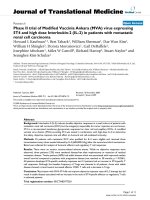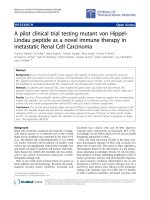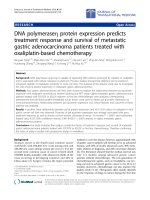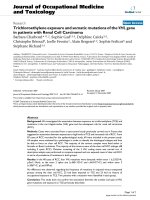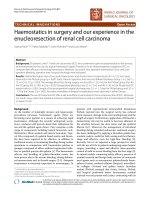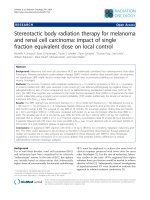Changes in therapy and survival of metastatic renal cell carcinoma in Estonia
Bạn đang xem bản rút gọn của tài liệu. Xem và tải ngay bản đầy đủ của tài liệu tại đây (579.99 KB, 7 trang )
Jürgens et al. BMC Cancer
(2020) 20:201
/>
RESEARCH ARTICLE
Open Access
Changes in therapy and survival of
metastatic renal cell carcinoma in Estonia
Hannes Jürgens1,2* , Kristiina Ojamaa3, Helis Pokker4, Kaire Innos5 and Peeter Padrik1,2
Abstract
Background: Before the era of targeted therapies, cytokines were the main therapy for metastatic renal cell
carcinoma (mRCC). Our aim was to analyze the changes in treatments and overall survival (OS) of all mRCC patients
in Estonia in relation to the introduction of new medications.
Methods: All patients with mRCC who started medical therapy in Estonia during the years 2004–2012 were
identified using the database of the Estonian Health Insurance Fund. Tumor and treatment data were gathered
from medical records. Vital status data were obtained from the Estonian Population Registry. The only available
therapy before 2008 was interferon alpha-2A (INFa2A), targeted agents added from 2008. For survival analysis,
patients were divided into 2 groups: INFa therapy only (group 1) and INFa followed by targeted agents or targeted
agents therapy only (group 2).
Results: Out of 416 identified patients, 380 were eligible for analysis. The most common 1st-line treatments were
INFa (55%), sunitinib (32%) and INFa+bevacizumab (13%). 28% of patients received 2nd-line therapies and 15% 3rdline treatments. Median survival of all patients was 13.7 months [95% confidence interval (CI) 11.3–16.2]; 7.6 months
(CI 6.4–8.6) for group 1 and 19.8 months (CI 15.6–22.9) for group 2. In multivariate analysis, group 1 had nearly four
times higher risk of dying than group 2 [hazard ration (HR) 3.88, 95% CI 2.64–5.72].
Conclusions: The implementation of targeted therapies significantly changed the outcomes of mRCC in Estonia: it
prolonged median survival, reduced the risk of death and also enlarged the proportion of patients who received
medical therapy.
Keywords: Metastatic renal cell carcinoma, National cohort, Overall survival, Targeted therapy
Background
Kidney cancer is the fifteenth most common cancer in
the world, with more than 400,000 new cases diagnosed
in 2018 [1]. Its incidence globally has been rising constantly –from 1990 to 2013 the increase was 2.1 fold [2].
Along with incidence, the mortality of kidney cancer is
increasing with estimation of 1,1% more deaths occurring each year [2]. The incidence of kidney cancer in
Estonia is among the five highest in Europe and also
* Correspondence:
1
Tartu University Hospital, Clinic of Hematology & Oncology, Puusepa 8,
Tartu, Estonia
2
University of Tartu, Clinic of Hematology & Oncology, Tartu, Estonia
Full list of author information is available at the end of the article
worldwide [age-standardized (World) incidence in 2018
21.3 per 100,000 in men and 9.7 in women] [1], but survival has been on the average European level (age-standardized relative survival for adult kidney cancers
diagnosed in 2000–2007 was 61.1% [95% confidence
interval (CI) 57.2–64.6] in Estonia, 60.6 (60.2–61.0) in
Europe and 55.8 (55.0–56.6) in Northern Europe) [3].
Data from 2010 to 2014 show further improvement in
the 5-year relative survival estimates of kidney cancer up
to 65% (62–69) in Estonia [4].
The main therapy of kidney cancer is surgery, but for
metastatic disease medical therapy is necessary. The introduction of modern targeted therapies has greatly improved the prognosis of patients with metastatic renal cell
© The Author(s). 2020 Open Access This article is licensed under a Creative Commons Attribution 4.0 International License,
which permits use, sharing, adaptation, distribution and reproduction in any medium or format, as long as you give
appropriate credit to the original author(s) and the source, provide a link to the Creative Commons licence, and indicate if
changes were made. The images or other third party material in this article are included in the article's Creative Commons
licence, unless indicated otherwise in a credit line to the material. If material is not included in the article's Creative Commons
licence and your intended use is not permitted by statutory regulation or exceeds the permitted use, you will need to obtain
permission directly from the copyright holder. To view a copy of this licence, visit />The Creative Commons Public Domain Dedication waiver ( applies to the
data made available in this article, unless otherwise stated in a credit line to the data.
Jürgens et al. BMC Cancer
(2020) 20:201
carcinoma (mRCC). The multitargeted tyrosine kinase inhibitors (TKIs) sunitinib [5, 6] and sorafenib [7] were the
first new therapies approved for advanced RCC and have
been available in the European Union since 2006.
In Estonia, interferon alpha-2A (INFa2A) monotherapy, which has been financed by the Estonian Health Insurance Fund, was the standard medical treatment until
2008 [8]. As of 2008, sorafenib was added to the secondline treatment of mRCC. As of the second half of 2009,
INFa2A and bevacizumab combination [9] and sunitinib
monotherapy are employed as the first-line treatment in
patients with low- and intermediate-risk, and temsirolimus [10] in patients with high-risk mRCC. Pazopanib
[11] treatment became routinely available from the second part of 2012 and axitinib from 2014 [12].
The effectiveness of the above-mentioned treatments
has been evaluated in the randomized prospective trials;
nevertheless, there is less information on what kind of
effect these treatments have on prolonging survival, taking into account the treatment outcomes of all patients
with mRCC.
Danish Renal Cancer Group has evaluated the implementation of targeted therapy in a complete national cohort of
patients, showing that this resulted in significantly improved treatment rates and overall survival [13]. Also,
Swedish and Norwegian studies reported the contribution
of targeted therapies to improved overall survival of mRCC
patients [14, 15]. Czech and Dutch studies have analyzed
mRCC registry based data on targeted therapies use in their
countries [16, 17]. Very recent publication from Sweden
suggested that the use of targeted therapies is also increasingly cost-effective over time in mRCC patients [18].
The aim of the current study was to analyze the
changes in treatment outcomes of mRCC in Estonia in
relation to the introduction of new medications and
international comparisons.
Methods
We used the database of the nation-wide Estonian
Health Insurance Fund to identify all patients with
mRCC in Estonia who received anticancer treatment
with following characteristics: age ≥ 18 years, diagnosis of
RCC [malignant neoplasm of the kidney, except renal
pelvis, International Classification of Diseases (ICD) version 10 code C64] and anticancer medications prescribed between January 1, 2004 and December 31,
2012. During the study period, all treatments included in
this study were reimbursed by the Estonian Health Insurance Fund. The mRCC patients were with metastatic
disease diagnosis from 2004 to 2012, including a number
of patients with a primary RCC diagnosis before the year
2004. We defined the following cohorts for primary
comparison purposes: patients with the diagnosis of
mRCC who started treatment from 2004 to 2012 with
Page 2 of 7
INFa only (group 1) or INFa followed by targeted agents
or targeted agents only (group 2). As new therapies became available from 2008, we set split-point to year
2008 in order to look at two equal time periods (2004–
2007 and 2008–2012) too.
For all identified patients we specified their clinical
data including treatments and treatment lines from clinical records (both paper and digital records) in three
hospitals that provide treatment for mRCC (North-Estonian Regional Hospital, Tartu University Clinic and
East-Tallinn Central Hospital). Vital status was updated
as of December 31, 2015 from the Estonian Population
Registry (3-year follow-up complete), using unique personal identification numbers. The completeness of the
study cohort was assessed through comparison with
RCC cases registered at the nation-wide populationbased Estonian Cancer Registry (2004–2007) that covers
the whole country. As new therapies became available
from 2008, we analyzed two different treatment periods
(2004–2007 and 2008–2012) too. The study protocol
was approved by the Ethics Review Committee on Human Research of the University of Tartu and Estonian
Data Protection Inspectorate.
The significance of difference between proportions
was estimated with chi-squared test. For survival analysis, the patients were followed from the date of treatment initiation until death from any cause or censored
at 3 years. Unadjusted Kaplan-Meier survival function
was estimated. Median survival (unadjusted) was calculated with 95% confidence intervals and the equality of
the medians between variable categories was tested with
Pearson chi-squared test. To identify the determinants
of survival, univariate and multivariate Cox proportional
hazards regression was used to calculate hazard ratios
(HR). The statistical significance of the HRs was assessed
using 95% confidence intervals. The proportional hazards assumption was tested. All calculations were conducted with STATA 14.1 (StataCorp LP, TX, USA).
Results
A total of 416 patients were identified, 380 were eligible
for analysis. 36 (9.5%) of the identified patients were excluded after the clinical record review due to different
reasons (17 patients’ treatment had started treatment before the year 2004; 4 patients had concurrent second
metastatic malignancy; 5 had non-RCC histology; 1 was
not getting treatment; 9 patients’ medical record data
was missing/incomplete). 33% of the patients were identified in group 1 and 67% in group 2.
When comparing the data retrieved from the Estonian
Health Insurance Fund with the data from the Estonian
Cancer Registry, we did not find any additional mRCC
cases in Estonia who received anticancer medical treatment during 2004–2007. However, 43% of RCC with
Jürgens et al. BMC Cancer
(2020) 20:201
Page 3 of 7
distant metastases cases reported to the Estonian Cancer
Registry did not receive medical treatment.
Patient characteristics are provided in Table 1.
Patients treated with INFa followed by targeted agents
or targeted agents only (group 2) had significantly longer
median survival compared to patients who received only
INFa (group 1) − 19.8 months (CI 15.6–22.9) versus 7.6
months (CI 6.4–8.6), p < 0.001(Table 1, Fig. 1).
INFa was the only 1st line treatment in the earlier study
period and targeted therapies dominated in the 2nd line of
therapy (Table 2). From the year 2008, the usage of targeted
therapies increased and by the year 2010 they almost replaced INFa immunotherapy in the 1st-line treatment. Remarkably, more patients received 2nd- and further line
treatments in the later treatment period compared to the
earlier period (Table 3). The most common 1st-line targeted agent was sunitinib and in the 2nd line sorafenib.
The median survival (unadjusted) was significantly
longer for patients whose tumors were removed (nephrectomy performed) versus not removed and for those
who had favorable Memorial Sloan Kettering Cancer
Center (MSKCC) prognosis versus intermediate and
poor prognosis (Table 4). Non-clear cell histology had a
significant negative influence on survival. We observed a
statistically not significantly longer survival in the later
treatment period versus the earlier, and female versus
male. Survival did not differ significantly between age
groups (Table 4).
Table 1 Patient characteristics and median survival from the time of treatment initiation, mRCC patients, Estonia 2004–2012
Treatment group 1a
Total
Treatment group 2b
N
%
N
%
N
%
380
100
125
100
255
100
15–59
120
32
42
34
78
31
60–69
134
35
45
36
89
35
70+
126
33
38
30
88
35
Male
252
66
83
66
169
66
Female
128
34
42
34
86
34
Clear Cell
313
82
82
66
231
91
Non-Clear cell
61
16
39
31
22
9
Unknown
6
2
4
3
2
1
314
83
102
81
212
83
Total
p-value
Age group
p = 0.706
Sex
p = 0.981
Histology
p < 0.001
Nephrectomy
Done
Not done
61
16
22
18
39
15
Other
5
1
1
1
4
2
2004–2007
137
36
107
86
30
12
2008–2012
243
64
18
14
225
88
p = 0.712
Treatment started
p < 0.001
Prognostic group (only 2008–2012)
Favorable
50
21
1
6
49
22
Intermediate
153
63
10
55
143
64
Poor
9
4
1
6
8
4
Unknown
31
13
6
33
25
11
Median survival in months (95% CI)
13.7 (11.3–16.2)
7.6 (6.4–8.6)
19.8 (15.6–22.9)
12-month
53% (48–58)
30% (22–38)
65% (59–71)
24-month
34% (29–38)
14% (9–21)
43% (37–49)
36-month
24% (20–28)
9% (5–15)
31% (25–37)
Survival#
a
INFa only
b
INFa followed by targeted agents or targeted agents only
p = 0.03
p < 0.001
Jürgens et al. BMC Cancer
(2020) 20:201
Page 4 of 7
cell histology (crude HR 2.00, adjusted HR 1.48), and patients who had not undergone nephrectomy vs those
who had (crude HR 1.90, adjusted HR 1.53). Female patients had lower risk of dying than male patients (crude
HR 0.73, adjusted HR 0.70).
Fig. 1 Kaplan-Meier survival curve, mRCC patients, Estonia 2004–
2012. Group 1- INFa only. Group 2- INFa followed by targeted
agents or targeted agents only
Cox proportional hazards regression analysis (Table 5)
showed that crude HR for death was 2.29 (95% CI 1.79–
2.92) for INFa only group (group 1) compared to INFa plus
2nd-line targeted therapy or targeted therapy only group
(group 2) during the 3 year follow-up after treatment
started. When adjusted for all variables (including treatment
period) in Table 5, the HR for group 1 was even larger
(3.88). Interestingly, crude HR for treatment period favored
later period but when adjusted for all variables, HR controversially favored earlier treatment period (1.00 vs 2.22).
The risk of dying was higher among patients with
non-clear cell histology compared to those with clear
Discussion
This study is a comprehensive assessment of mRCC
treatments during the era of pretargeted and targeted
therapies that used data derived directly from the clinical
records of patients. We found that both overall survival
(OS) and the hazard ratio (HR) for mortality of the
treated patients improved significantly along with the
use of new treatments. The only available 1st-line treatment with INFa immunotherapy during the years 2004–
2007 was replaced by targeted therapies during 2008–
2012. Significantly more patients received 2nd- and 3rd
line treatments during the later period.
Until year 2015 results from large randomized trials of
various mRCC treatments showed only a significant improvement of progression-free survival (PFS) [5–7, 9, 11,
12] and very seldom improved OS [10] of properly selected mRCC patients. Researchers explained it with
cross-over effect and other subsequent effective treatments that confounded the results. Within the past 3
years there is growing evidence that the landscape of
treatments is changing. Novel drugs cabozantinib and
immonotherapy drug nivolumab were shown to improve
OS of mRCC patients after treatment failure with TKI-s
[19, 20]. According to more recent publication of phase
Table 2 Overview of 1st- and 2nd-line treatments during the study period, mRCC patients, Estonia 2004–2012
First line treatment
2004–2007
2008
2009
2010
2011
2012
2008–2012
2004–2012
137
26
50
47
58
62
243
380
Immunotherapy INFa (%)
137 (100)
24 (92)
24 (48)
2 (4)
2 (3)
1 (2)
53 (22)
207 (55)
Targeted therapy (%)
0 (0)
2 (8)
26 (52)
45 (96)
56 (97)
61 (98)
190 (78)
190 (50)
INFa+Bevacizumab
0
1
7
17
14
12
51
51 (13)
Sunitinib
0
0
16
26
38
42
122
122 (32)
Sorafenib
0
1
1
1
2
0
5
5 (1)
Temsirolimus
0
0
2
1
2
4
9
9 (2)
Pazopanib
0
0
0
0
0
3
3
3 (1)
Second line treatment
4
15
21
23
24
18
101
105
Immunotherapy INFa (%)
0 (0)
0 (0)
0 (0)
0 (0)
0 (0)
1 (6)
1 (1)
1 (1)
Targeted therapy (%)
4 (100)
15 (100)
21 (100)
23 (100)
24 (100)
17 (94)
100 (99)
104 (99)
INFa+Bevacizumab
0
0
0
1
2
4
7
7 (7)
Sunitinib
0
0
2
3
7
1
13
13 (12)
Sorafenib
2
15
18
17
12
12
74
76 (72)
Temsirolimus
0
0
1
2
1
0
4
4 (4)
Pazopanib
2
0
0
0
0
0
0
2 (2)
Everolimus
0
0
0
0
2
0
2
2 (2)
Jürgens et al. BMC Cancer
(2020) 20:201
Page 5 of 7
Table 3 Distribution of treatment lines over the study years, mRCC patients, Estonia 2004–2012
2004–2007
2008
2009
2010
2011
2012
2004–2012
154 (100)
26 (100)
50 (100)
47 (100)
58 (100)
62 (100)
397 (100)
Treatment lines
First line
Second line
6 (4)
16 (62)
21 (42)
24 (51)
24 (41)
19 (31)
110 (28)
Third line
0 (0)
5 (19)
8 (16)
15 (32)
18 (31)
11 (18)
57 (14)
Fourth line
0 (0)
0 (0)
2 (4)
2 (4)
3 (5)
3 (5)
10 (3)
III trial by Motzer et al. [21] immunotherapy combination of nivolumab and ipilimumab improved the outcome [objective response rate (ORR), OS and PFS]
already in first line compared to sunitinib in intermediate and poor prognostic group of mRCC patients. At the
time of many proven effective drugs available on the
market for mRCC, the question which drug or combination of drugs ultimately give the best result for a specific patient, still remain doctors to decide without clear
evidence-based answer.
Among national cohort studies of mRCC, there are 4
trials from Europe: Norwegian [15], Swedish [14] and
Czech Republic [16] trial based on data from local registries and a Danish trial that used detailed and complete
Table 4 Median survival from the time of treatment initiation
by variable categories, mRCC patients, Estonia 2004–2012
Median survival in months (95% CI)
Total
13.7 (11.3–16.2)
Age group
15–59
11.1 (8.0–17.7)
60–69
14.6 (11.7–20.6)
70+
13.1 (9.2–19.0)
p = 0.667
Treatment started
2004–2007
9.7 (8.1–14.8)
2008–2012
15.4 (12.2–19.8)
p = 0.087
Sex
Male
11.9 (9.1–15.4)
Female
18.3 (12.1–22.9)
p = 0.104
Nephrectomy
Done
16.0 (13.1–19.5)
Not done
7.0 (3.8–8.7)
p < 0.001
Histology
Clear Cell
16.1 (12.9–19.5)
Non-Clear Cell
7.0 (4.7–9.7)
p = 0.002
Prognostic group
(only 2008–2012)
Favorable
28.4 (22.2–55.7)
Intermediate
13.2 (10.4–16.9)
Poor
2.4 (1.1–8.5)
Unknown
15.2 (5.5–21.0)
p < 0.001
national data from medical records [13]. Our findings on
the improvement of survival and treatment changes are
comparable with those trials. For instance, in the Danish
report the median OS of treated mRCC patients was
11.5 months in 2008 and 17.2 months in 2010 compared
to our median OS of 13.7 months for patients during the
whole trial period and 7.6 months for group 1 and 19.8
months for group 2 [13]. There are also similar results
on median survival of different risk groups (although the
Danish group used Heng and we used MSKCC risk criteria which are somewhat different): 33.4, 18.6 and 5.8
months in the Danish trial compared to our 28.8, 13.2
and 2.4 months for good, intermediate and poor risk patients, accordingly [13]. Nephrectomy was performed in
83% of treated patients (equally in both treatment
groups and time periods) which is a much higher rate
than previously reported in Scandinavian countries
Norway, Sweden and Denmark - 65, 60 and 61%, respectively [13, 14]. Similar nephrectomy rate was reported from the Czech Republic trial (83%) [16]. The
patients who had had nephrectomy, had significantly
better survival compared with non-operated patients.
Similar findings including improved disease specific
survival along with the use of new treatments (targeted
therapy era) have been reported from mRCC studies in
the US as well [22].
Due to the retrospective design of this trial, there are
some limitations. One limitation of this study is the incompleteness of data from medical records (2% of patients were excluded due to major incompleteness of
data; 13% of patients had unknown MSKCC risk group
status and 2% unknown histology) that might give rise
to bias when interpreting results. Yet, survival data are
complete due to the reliability and completeness of national registries. There is also a possible selection bias
regarding nephrectomy to be more likely performed in
patients with better general condition/prognosis and
therefore leading to better survival. Selection bias might
also be the case when giving 2nd and later line treatment
for patients who are in a better condition/prognosis, especially after immunotherapy failure, and poor risk patients who had the only available reimbursed treatment
option of INFa until the second half of 2009, while good
and intermediate risk patients had 2nd line treatment
option with sorafenib from the year 2008. The larger
Jürgens et al. BMC Cancer
(2020) 20:201
Page 6 of 7
Table 5 Hazard ratios for all-cause mortality during the 3-year follow-up after treatment initiationa, mRCC patients, Estonia 2004–
2012
Crude HR
95% CI
Adjustedb HR
95% CI
Adjustedb HR
95% CI
Treatment group
Group 2c
1.00
d
2.29
Group 1
1.00
1.79–2.92
2.15
1.00
1.65–2.79
3.88
2.64–5.72
Age group
15–59
1.00
60–69
0.83
0.63–1.11
1.00
0.89
0.67–1.19
1.00
0.85
0.64–1.14
70+
0.94
0.71–1.26
0.96
0.71–1.28
0.87
0.64–1.17
Sex
Male
1.00
Female
0.73
1.00
0.57–0.94
0.70
1.00
0.54–0.91
0.71
0.55–0.93
Histology
Clear Cell
1.00
Non clear cell
2.00
1.00
1.49–2.69
1.36
1.00
0.99–1.87
1.48
1.07–2.04
Nephrectomy
Done
1.00
Not done
1.90
1.00
1.41–2.57
1.62
1.00
1.19–2.21
1.53
1.12–2.09
Treatment period
2004–2007
1.00
2008–2012
0.81
0.63–1.03
–
1.00
–
2.22
1.52–3.24
a
patients with unknown histology (n = 6) and other surgery (n = 5) excluded
b
adjusted for all variables in the table
c
treatment with INFa followed by targeted agents or targeted agents only
d
treatment with INFa only
proportion of early period INFa treatment responders
proceeding to 2nd line treatment in later period may explain why HR adjusted for all variables, including treatment period, controversially favored the earlier
treatment started period to the later. Case numbers in
some variable categories were too low to provide reliable
results.
Another important fact is that 43% of RCC patients with
distant metastases reported in the Estonian Cancer Registry did not receive medical treatment (a finding from data
comparison). Unfortunately, there is no data on how many
of them were referred for treatment and how many were
not referred and what were the reasons for not being referred or not getting treatment. The Danish trial [11] reported that among all referred mRCC patients 29% did
not receive treatment due to different reasons (poor PS,
patient request, death before the start of treatment, etc.).
The proportion of patients not being referred and the reasons thereof remain unknown but we hope that in the future, new effective treatment possibilities will raise the
awareness of the broader medical community about the
reasonability of medical treatment in mRCC.
Patients who receive targeted therapies have a significant (more than two-fold) prolongation of median survival and reduction in risk of death compared to INFa
treatment only, and therefore, this also provides better
justification for positive reimbursement decisions in the
future for the benefit of patients.
Conclusions
The results from our Estonian retrospective study of
mRCC patients are consistent with findings from the
previously reported real-life and national cohort studies
from Europe. The implementation of targeted therapies
significantly changed the outcomes of mRCC: it prolonged median survival, reduced the risk of death and
also enlarged the proportion of patients who received
medical therapy.
Abbrevations
CI: Confidence interval; HR: Hazard ratio; INFa: Interferon alpha;
MRCC: Metastatic renal cell carcinoma; ORR: Objective response rate;
OS: Overall survival; PFS: Progression-free survival; TKI: Tyrosine kinase
inhibitor; US: United States
Acknowledgements
The authors acknowledge Dr. Rena Tiigi (North Estonian Regional Hospital,
Tallinn, Estonia) contribution in collecting data.
Availability of data and material
The datasets generated and analyzed during the current study are not
publicly available due to protocol and local regulations but are available
from the corresponding author on reasonable request.
Jürgens et al. BMC Cancer
(2020) 20:201
Authors’ contributions
HJ contributed to the design of work, collected, interpreted and revised
data. KO contributed with data collection, interpretation and revision of
work. HP contributed with data collection, interpretation and revision of
work. PP contributed to the conception and design of work, interpreted and
revised data and work. KI contributed in statistical analysis of data, revision of
work. All authors read and approved the final manuscript.
Funding
This work was supported by the Estonian Society of Medical Oncology.
The funding source had no involvement in study design, collection, analysis
and interpretation of data, writing of the report and in the decision to
submit the article for publication.
Ethics approval and consent to participate
The study protocol was approved by the Ethics Review Committee on
Human Research of the University of Tartu and Estonian Data Protection
Inspectorate.
Due to retrospective design of the study, no consents were needed nor
taken.
Consent for publication
Not applicable.
Competing interests
The authors declare that they have no competing interests.
Author details
1
Tartu University Hospital, Clinic of Hematology & Oncology, Puusepa 8,
Tartu, Estonia. 2University of Tartu, Clinic of Hematology & Oncology, Tartu,
Estonia. 3East Tallinn Central Hospital, Tallinn, Estonia. 4North Estonian
Regional Hospital, Tallinn, Estonia. 5Department of Epidemiology and
Biostatistics, National Institute for Health Development, Tallinn, Estonia.
Received: 28 February 2019 Accepted: 26 February 2020
References
1. Ferlay J, Ervik M, Lam F, Colombet M, Mery L, Piñeros M, Znaor A,
Soerjomataram I, Bray F. Global Cancer observatory: Cancer today. Lyon:
International Agency for Research on Cancer; 2018. Available from: https://
gco.iarc.fr/today.
2. Dy GW, Gore JL, Forouzanfar MH, Naghavi M, Fitzmaurice C. Global burden
of urologic cancers, 1990-2013. Eur Urol. 2017;71(3):437–46.
3. Marcos-Gragera R, Mallone S, Kiemeney LA, Vilardell L, Malats N, Allory Y,
et al. Urinary tract cancer survival in Europe 1999-2007: Results of the
population-based study EUROCARE-5. Eur J Cancer. 2015;51(15):2217-30.
4. Innos K, Sepp T, Baburin A, Kotsar A, Lang K, Padrik P, Aareleid T. Increasing
kidney cancer incidence and survival in Estonia: role of age and stage. Acta
Oncol. 2019;58(1):21–8.
5. Motzer RJ, Hutson TE, Tomczak P, Michaelson MD, Bukowski RM, Oudard S,
et al. Overall survival and updated results for sunitinib compared with
interferon alfa in patients with metastatic renal cell carcinoma. J Clinical
Oncol. 2009;27(22):3584–90.
6. Motzer RJ, Hutson TE, Cella D, Reeves J, Hawkins R, Guo J, et al. Pazopanib
versus sunitinib in metastatic renal-cell carcinoma. N Engl J Med. 2013;
369(8):722–31.
7. Escudier B, Eisen T, Stadler WM, Szczylik C, Oudard S, Siebels M, et al.
Sorafenib in advanced clear-cell renal-cell carcinoma. N Engl J Med. 2007;
356(2):125–34.
8. Motzer RJ, Bacik J, Murphy BA, Russo P, Mazumdar M. Interferon-alfa as a
comparative treatment for clinical trials of new therapies against advanced
renal cell carcinoma. J Clin Oncol. 2002;20(1):289–96.
9. Escudier B, Bellmunt J, Negrier S, Bajetta E, Melichar B, Bracarda S, et al.
Phase III trial of bevacizumab plus interferon alfa-2a in patients with
metastatic renal cell carcinoma (AVOREN): final analysis of overall survival. J
Clin Oncol. 2010;28(13):2144–50.
10. Hudes G, Carducci M, Tomczak P, Dutcher J, Figlin R, Kapoor A, et al.
Temsirolimus, interferon alfa, or both for advanced renal-cell carcinoma. N
Engl J Med. 2007;356(22):2271–81.
Page 7 of 7
11. Sternberg CN, Davis ID, Mardiak J, Szczylik C, Lee E, Wagstaff J, et al.
Pazopanib in locally advanced or metastatic renal cell carcinoma: results of
a randomized phase III trial. J Clin Oncol. 2010;28(6):1061–8.
12. Rini BI, Escudier B, Tomczak P, Kaprin A, Szczylik C, Hutson TE, et al.
Comparative effectiveness of axitinib versus sorafenib in advanced renal cell
carcinoma (AXIS): a randomised phase 3 trial. Lancet. 2011;378(9807):1931–9.
13. Soerensen AV, Donskov F, Hermann GG, Jensen NV, Petersen A, Spliid H,
et al. Improved overall survival after implementation of targeted therapy for
patients with metastatic renal cell carcinoma: results from the Danish renal
Cancer group (DARENCA) study-2. Eur J Cancer. 2014;50(3):553–62.
14. Wahlgren T, Harmenberg U, Sandström P, Lundstam S, Kowalski J,
Jakobsson M, et al. Treatment and overall survival in renal cell carcinoma: a
Swedish population-based study (2000-2008). Br J Cancer. 2013;108(7):1541–
9.
15. Beisland C, Johannesen TB, Klepp O, Axcrona U, Torgersen KM, Kowalski J,
et al. Overall survival in renal cell carcinoma after introduction of targeted
therapies: a Norwegian population-based study. Onco Targets Ther. 2017;10:
371–85.
16. Poprach A, Bortlíček Z, Büchler T, Melichar B, Lakomý R, Vyzula R, et al.
Patients with advanced and metastatic renal cell carcinoma treated with
targeted therapy in the Czech Republic: twenty cancer centres, six agents,
one database. Med Oncol. 2012;29(5):3314–20.
17. De Groot S, Sleijfer S, Redekop WK, Oosterwijk E, Haanen JB, Kiemeney LA,
et al. Variation in use of targeted therapies for metastatic renal cell
carcinoma: results from a Dutch population-based registry. BMC Cancer.
2016;16:364.
18. Redig J, Dalen J, Harmenberg U, Lindskog M, Ljungberg B, Lundstam S,
et al. Real-world cost-effectiveness of targeted therapy in metastatic renal
cell carcinoma in Sweden: a population-based retrospective analysis. Cancer
Manag Res. 2019;11:1289–97.
19. Choueiri TK, Escudier B, Powles T, Tannir NM, Mainwaring PN, Rini BI, et al.
Cabozantinib versus everolimus in advanced renal cell carcinoma (METEOR):
final results from a randomised, open-label, phase 3 trial. Lancet Oncol.
2016;17(7):917–27.
20. Motzer RJ, Escudier B, McDermott DF, George S, Hammers HJ, Srinivas S,
et al. Nivolumab versus Everolimus in advanced renal-cell carcinoma. N Engl
J Med. 2015;373(19):1803–13.
21. Motzer RJ, Tannir NM, McDermott DF, Aren Frontera O, Melichar B, Choueiri
TK, et al. Nivolumab plus Ipilimumab versus Sunitinib in advanced renal-cell
carcinoma. N Engl J Med. 2018;378(14):1277–90.
22. Pal SK, Nelson RA, Vogelzang N. Disease-Specific Survival in De Novo
Metastatic Renal Cell Carcinoma in the Cytokine and Targeted Therapy Era.
PLoS ONE. 2013;8(5):e63341. />
Publisher’s Note
Springer Nature remains neutral with regard to jurisdictional claims in
published maps and institutional affiliations.


